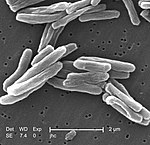Interferon gamma release assay
Interferon-γ release assays (IGRA) are medical tests used in the diagnosis of some infectious diseases, especially tuberculosis. Interferon-γ (IFN-γ) release assays rely on the fact that T-lymphocytes will release IFN-γ when exposed to specific antigens. These tests are mostly developed for the field of tuberculosis diagnosis, but in theory, may be used in the diagnosis of other diseases that rely on cell-mediated immunity, e.g. cytomegalovirus and leishmaniasis and COVID-19.[1] For example, in patients with cutaneous adverse drug reactions, the challenge of peripheral blood lymphocytes with the drug causing the reaction produced a positive test result for half of the drugs tested.[2]
There are currently two IFN-γ release assays available for the diagnosis of tuberculosis:
- QuantiFERON-TB Gold (licensed in US, Europe and Japan); and
- T-SPOT.TB, a form of ELISpot, the variant of ELISA (licensed in Europe, US, Japan and China).[3]
The former test quantitates the amount of IFN-γ produced in response to the ESAT-6 and CFP-10 antigens from Mycobacterium tuberculosis, which are distinguishable from those present in BCG and most other non-tuberculous mycobacteria. The latter test determines the total number of individual effector T cells expressing IFN-γ.[citation needed]
The indications for the test are still disputed. It has been evaluated for the diagnosis of latent tuberculosis in HIV patients (who frequently have a negative Mantoux test).[4]
IFN-γ release assays for the diagnosis of SARS-CoV-2 (COVID-19): The blood samples were collected in a set of lithium heparin tubes; The first tube without stimulation was left as a control; the second tube was stimulated with a single SARS-CoV-2 peptide pool for CD4+ T cells and the third tube was stimulated with a SARS-CoV-2 peptide pool for CD8+ T cells; the fourth tube was stimulated with mitogen as positive control. A single CD4+ T-cell mega pool (CD4+ pool) consisted of 221 predicted HLA class II CD4+ T-cell epitope peptides covering the entire viral proteome except for the spike protein, which was covered with 253 15-mer peptides overlapping by 10 residues and 2 CD8+ T-cell mega pools (CD8+ pools A and B) together consisting of 628 predicted HLA class I CD8+ T-cell epitopes from the entire SARS-CoV-2 proteome. After an overnight stimulation of the T-cells, the IFN-γ concentration in the plasma fraction was measured by enzyme-linked immunosorbent assay (ELISA) in international units per milliliter (IU/mL) (Murugesan et al, 2021).[1]
References
- ^ a b Murugesan, Kanagavel; Jagannathan, Prasanna; Pham, Tho D.; Pandey, Suchitra; Bonilla, Hector F.; Jacobson, Karen; Parsonnet, Julie; Andrews, Jason R.; Weiskopf, Daniela; Sette, Alessandro; Pinsky, Benjamin A.; Singh, Upinder; Banaei, Niaz (2021). "Interferon-γ Release Assay for Accurate Detection of Severe Acute Respiratory Syndrome Coronavirus 2 T-Cell Response". Clinical Infectious Diseases. 73 (9): e3130 – e3132. doi:10.1093/cid/ciaa1537. PMC 7665338. PMID 33035306.
- ^ Halevy, S.; Cohen, A.; Grossman, N. (2005). "Clinical implications of in vitro drug-induced interferon-gamma release from peripheral blood lymphocytes in cutaneous adverse drug reactions". Journal of the American Academy of Dermatology. 52 (2): 254–261. doi:10.1016/j.jaad.2004.05.006. PMID 15692470.
- ^ "How the T-SPOT.TB Test Works".
- ^ Lawn SD, Bangani N, Vogt M, et al. (2007). "Utility of interferon-γ ELISPOT assay responses in highly tuberculosis-exposed patients with advanced HIV infection in South Africa". BMC Infectious Diseases. 7: 99. doi:10.1186/1471-2334-7-99. PMC 2031899. PMID 17725839.
